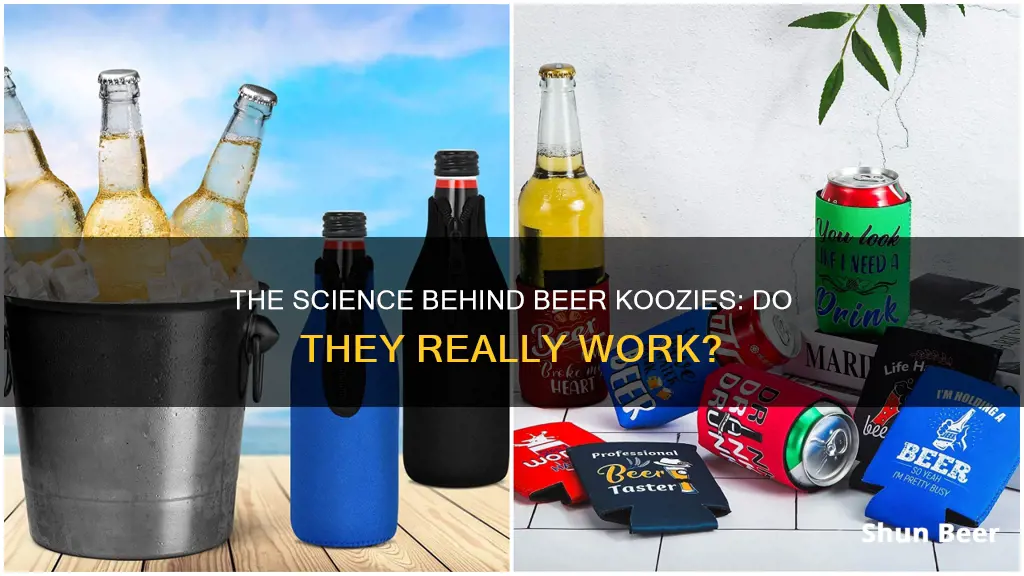
Beer koozies are known to be great insulators, providing a barrier between a can or bottle and the outside temperature, keeping the cold in and the warm out. But do they actually work? In this article, we will explore the science behind beer koozies and find out if they are effective in keeping your beer cold. We will also discuss the impact of factors such as packaging material and time spent in hand, and provide experimental results to determine the effectiveness of beer koozies in maintaining the chill of your favourite beverage.
| Characteristics | Values |
|---|---|
| Effectiveness | Differs depending on packaging material (can vs. bottle) and time spent in hand/on mouth |
| Purpose | Keep beer colder for longer |
| How it works | Acts as a barrier between the can/bottle and the outside temperature; Prevents condensation from forming on the outside of the can/bottle |
| Materials | Polyurethane, neoprene, and foam |
What You'll Learn

Beer koozies are great insulators
Customized koozies are made of materials that are extremely poor conductors of heat. Polyurethane and neoprene, for example, are commonly used in the construction of koozies and act as a barrier to slow down the rate of temperature change within the can. By wrapping beverage cans with these materials, the amount of time it takes for the liquid inside to heat up is significantly lengthened.
To test the effectiveness of beer koozies, two cans of previously refrigerated beer were placed side-by-side outside in the direct sun. One beer was slipped inside a foam koozie, while the other was left uncovered. After just 30 minutes, the uncovered beer was 8.8 degrees Celsius warmer than the koozie-wrapped beer. This demonstrates how quickly the sun can heat up unprotected beverages.
The sleeve of the koozie doesn't actively cool the liquid inside the can; instead, it slows down the rate at which the temperature of the liquid changes. This is why beer koozies are so effective at keeping drinks cold. They act as a barrier between the cold can and the warm air, making it harder for the air to transfer its heat to the drink.
The effectiveness of a koozie also depends on factors such as the packaging material of the drink (can vs. bottle) and the time spent in hand/on the mouth. However, in general, beer koozies are great insulators that can help keep your drink cold for longer periods of time.

They create a barrier to keep the cold in and the warm out
Beer koozies are great insulators that work by creating a barrier to keep the cold in and the warm out. They are made of materials that are extremely poor conductors of heat, such as polyurethane and neoprene. By wrapping beverage cans with these materials, the amount of time it takes for the liquid inside to heat up is significantly lengthened.
In other words, the koozie doesn't actively cool the liquid inside the can, but it slows down the rate at which the temperature of the liquid changes. This is because the koozie acts as a barrier that reduces heat exchange between the can and the atmosphere. The same principle applies to reducing the conduction of energy between your hand and the can.
The effectiveness of a koozie depends on several factors, including the type of material it is made of, the temperature difference between the air and the beverage, the rate at which the air is flowing past the can, and the time spent in hand/on the mouth. However, in general, koozies are very effective at keeping beverages cold for longer periods of time, especially in warm outdoor conditions.
For example, in one experiment, two cans of beer were placed side-by-side outside in direct sunlight. One beer was slipped inside a foam koozie, while the other was left uncovered. After just 30 minutes, the uncovered beer was 8.8 degrees Celsius warmer than the koozie-wrapped beer. This demonstrates how quickly beverages can heat up in the sun without protection.
In conclusion, beer koozies are effective at keeping beverages cold by creating a barrier that slows down the rate of temperature change and reduces heat exchange between the can and its surroundings. So, if you're looking to keep your beer chilly on a hot day, a koozie is a great solution!

They reduce condensation, which keeps the beverage cooler for longer
Beer koozies are an effective way to keep your drink cooler for longer. While they don't actively cool the liquid inside the can, they do slow down the rate at which the drink warms up. This is achieved through insulation, creating a barrier that reduces heat exchange.
The material of a koozie is an important factor in its effectiveness. Polyurethane and neoprene koozie materials are extremely poor conductors of heat. By wrapping beverage cans with these materials, the time it takes for the drink to warm up is significantly lengthened. This is because the koozie acts as a barrier, reducing the amount of conduction between the can and the atmosphere, as well as between your hand and the can.
In addition to insulation, koozies also help to reduce condensation. Steven Quiring, a professor of atmospheric sciences at OSU, explains that condensation is the process by which water moves from a higher energy state (vapour) to a lower energy state (liquid). This releases latent heat, some of which will warm the beverage. By reducing condensation, koozies are able to keep beverages cooler for longer.
The effectiveness of a koozie also depends on factors such as the packaging material of the drink (e.g. can vs. bottle) and the time spent in hand/on mouth. However, experiments have shown that even simple foam koozies can make a noticeable difference in keeping drinks cool.

The effectiveness of a koozie depends on the packaging material and time spent in hand
The effectiveness of a koozie depends on several factors, including the packaging material and the time spent in hand. In terms of packaging material, the koozie's ability to insulate and slow down the rate of temperature change is key. Polyurethane and neoprene, commonly used in koozies, are poor conductors of heat, creating a barrier that slows the transfer of heat from the air to the beverage. This is particularly effective when compared to the thin wall of an aluminium can, which allows the beverage to warm up quickly.
The shape and size of the koozie in relation to the can or bottle also matter. A well-fitting koozie with a secure closure will provide better insulation than one that is loose or has gaps. Additionally, the thickness of the koozie material can impact its effectiveness, with thicker materials generally providing better insulation.
Time spent in hand is another critical factor. The longer a beverage is held, the more heat is transferred from the hand to the can and subsequently to the beverage. A koozie acts as a barrier, reducing the conduction of energy between the hand and the can, thus keeping the beverage cooler for a more extended period. This is especially noticeable during outdoor activities in warm weather when the surrounding temperature is higher.
The type of beverage container, such as a can or bottle, can also influence the effectiveness of a koozie. In general, cans have a larger surface area in contact with the outside environment, which can result in faster heat transfer. Therefore, a koozie may have a more noticeable impact on canned beverages compared to bottled ones.
It's worth noting that while koozies help maintain carbonation levels and slow the warming of beverages, they don't actively cool the liquid inside. Their effectiveness also depends on the initial temperature of the beverage and the ambient temperature. However, in controlled experiments, koozies have proven to keep beverages colder for longer, enhancing the drinking experience by preserving the desired temperature and carbonation.

They are particularly useful in hot, humid climates
Beer koozies are particularly useful in hot, humid climates. They act as a barrier between the can or bottle and the outside temperature, keeping the cold in and the warm out. The effectiveness of a koozie depends on its material—polyurethane and neoprene koozie materials are extremely poor conductors of heat. In hot and humid climates, the sleeve doesn't actively cool the liquid inside the can, but it does slow down the rate of temperature change within the can.
In hot and humid climates, the power of the sun can quickly heat up unprotected beverages. For example, in one experiment, a naked beer hit a temperature of 87.8 degrees Fahrenheit when left outside in 77-degree weather for three hours. In contrast, a beer wrapped in a koozie maintained a temperature of 77 degrees at the end of the test. This demonstrates how koozies can help keep drinks colder for longer in hot and humid climates.
The koozie also helps to reduce condensation, which can lead to a warmer beverage. Condensation is the process by which water moves from a higher energy state (vapour) to a lower energy state (liquid). This releases latent heat, some of which will warm the beverage. By reducing condensation, the koozie helps to keep the drink cooler for longer.
In addition to keeping drinks cold, koozies also have the added benefit of keeping your hand from getting cold. This can be especially useful in hot and humid climates, where a cold drink is often desired but holding a cold can or bottle can be uncomfortable.
Frequently asked questions
Yes, beer koozies work. They act as a barrier between the can/bottle and the outside temperature, keeping the cold in and the warm out.
Beer koozies work by providing a poor heat-conducting barrier between the beverage and the outside environment. The polyurethane and neoprene koozie materials are extremely poor conductors of heat, so wrapping beverage cans with these materials slows down the rate of temperature change within the can.
Yes, beer koozies are particularly effective in hot and humid conditions. This is because condensation has a bigger impact on the temperature of the can in these conditions, and koozies help to prevent condensation from forming.







